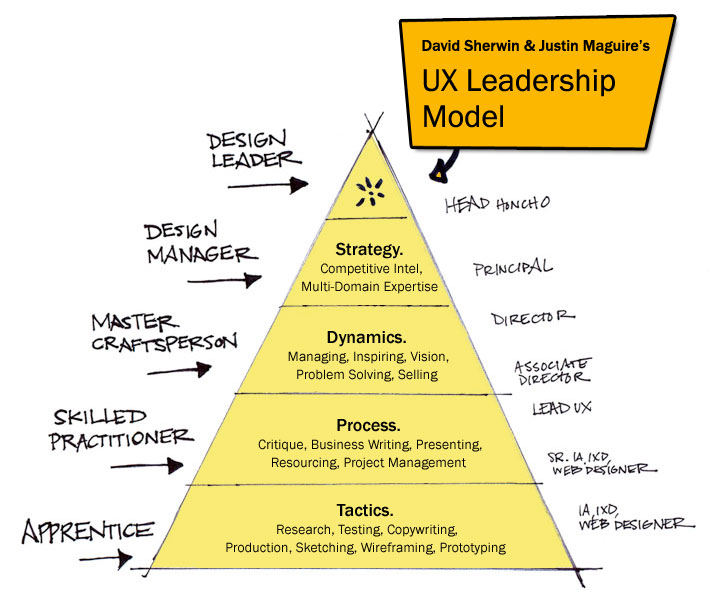When you’re looking for something online, one thing usually leads to something else. In this case, the something else I came upon is not a UX product pyramid, but a UX practitioner pyramid.
It comes from none but Leah Buley (Adaptive Path, author of “The UX team of One”), which in turns builds upon a model from David Sherwin and Justin Maguire (Frog).

In her very short but great article she touches on a few points that usually come up in the initial conversations with a client, especially when they call us for UX training.
A point she makes is that “making sure that you have someone on staff who can do tactical UX will only get you so far if you don’t also have people on staff who cover the other layers”. In other words, UX is not just a set of design principles, but a comprehensive practice that spans across the entire organization, and goes beyond the design team.
However, most companies tend to stop at the UI level of UX (that is, they stop at the visual design level), without incorporating the more strategic aspects which are not necessarily (visual) design-related but rather product and business centered.
And this is the other distinction that Leah points out: the tactical and strategic functions of design. Design at the tactical level involves a different toolbox and set of skills than design at the strategic level. Take Product Managers for instance: they execute design in an entirely different way than tactical designers.
And the conversation about design at the strategic level, brought to mind a chart (and study) that I can’t use often enough when I talk about the strategic value of UX. This chart, which was produced by Jeneanne Rae and appears in her HBR article Design Can Drive Exceptional Returns for Shareholders shows how companies that incorporate design at all levels of the company can be worth more than 200% than companies that don’t.
In other words, she clearly shows how design has direct impact on the bottom line, the company value and how it can be a key generator of value.

When you’re looking for something online, one thing usually leads to something else. In this case, the something else I came upon is not a UX product pyramid, but a UX practitioner pyramid.
It comes from none but Leah Buley (Adaptive Path, author of “The UX team of One”), which in turns builds upon a model from David Sherwin and Justin Maguire (Frog).

In her very short but great article she touches on a few points that usually come up in the initial conversations with a client, especially when they call us for UX training.
A point she makes is that “making sure that you have someone on staff who can do tactical UX will only get you so far if you don’t also have people on staff who cover the other layers”. In other words, UX is not just a set of design principles, but a comprehensive practice that spans across the entire organization, and goes beyond the design team.
However, most companies tend to stop at the UI level of UX (that is, they stop at the visual design level), without incorporating the more strategic aspects which are not necessarily (visual) design-related but rather product and business centered.
And this is the other distinction that Leah points out: the tactical and strategic functions of design. Design at the tactical level involves a different toolbox and set of skills than design at the strategic level. Take Product Managers for instance: they execute design in an entirely different way than tactical designers.
And the conversation about design at the strategic level, brought to mind a chart (and study) that I can’t use often enough when I talk about the strategic value of UX. This chart, which was produced by Jeneanne Rae and appears in her HBR article Design Can Drive Exceptional Returns for Shareholders shows how companies that incorporate design at all levels of the company can be worth more than 200% than companies that don’t.
In other words, she clearly shows how design has direct impact on the bottom line, the company value and how it can be a key generator of value.





